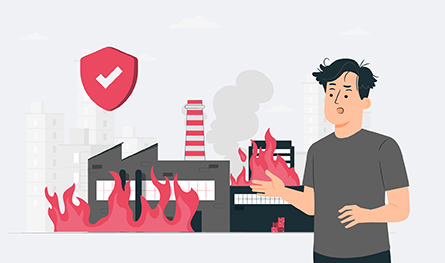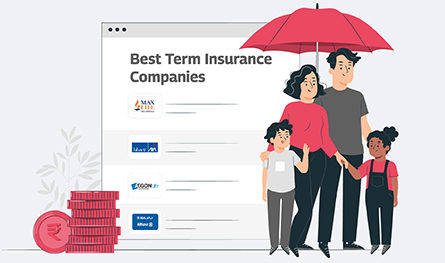What is Fire Loss of Profit Insurance Policy (FLOP)

FLOP which stands for ‘Fire Loss of Profit’ is an insurance plan that protects businesses from losses incurred due to cases of fire damages. Also known as Consequential Loss insurance, this is a very important policy for every business. Let us know more about a fire loss of profit insurance in this post.

- How Does Consequential Fire Loss of Profit Insurance Policy Work?
- Scope of Cover Under Loss of Profit Policy
- Benefits of Fire loss of profit insurance policy
- How is a Fire Loss of Profit Insurance Policy different from a Fire Insurance Plan?
- Who should buy a fire insurance policy?
- What Is Advance Loss of Profit (ALOP) Insurance?
- Exclusions to the Fire Loss of Profit Insurance Policy
- Formula to Calculate Loss of Profit
How Does Consequential Fire Loss of Profit Insurance Policy Work?
To understand how Fire Loss of Profit Insurance Policy can help you mitigate risk and give protection from loss of net trading profit. Let’s check this example
- Mr. Andrew bought a Fire and Special Perils policy to cover his textile factory. He purchased a Loss of Profit / Consequential Loss Policy as well.
- A major fire caused property damage to the finishing section of his factory, which led to disruption of business for 2 months.
- Loss of goods and damage to machinery amounted to Rs. 1 crore, which was covered by the insurance company under the Fire and Special Perils Policy.
- There was also a significant loss of turnover since the factory was closed after the fire.
- This loss was aggravated by the fact that Mr. Andrew was required to continue paying standing charges such as rent and wages even though the period of closure.
- Since Mr. Andrews had a Consequential Loss Policy also, he could file a claim to cover the reduction in Gross Profit.
- As the closure of the factory was caused by the operation of a peril covered under the Fire Insurance policy, the insurance company also admitted liability under the Loss of Profit policy. A claim amount of Rs. 2.50 crore towards loss of Gross Profit was paid.
Scope of Cover Under Loss of Profit Policy
The Policy Covers Loss of:
Net Profit + Standing Charges + Expenses incurred necessarily and reasonably to bring the business back on track
A Loss of Profit Policy may carry an excess/deductible expressed in a number of days. This indicates the days immediately after the loss, which would not be included while computing the reduction in Gross Profit.
- Extensions: The policy can be extended to cover:
- Wages
- Accidental failure of public electricity/gas/water supply
- Damage to customer’s premises due to perils covered under Fire Policy
- Damage to Supplier’s premises due to perils covered under Fire Policy
- Auditor’s fees
- Lay –off and/ or retrenchment Compensation with or without Notice Wages Liability
- Sum Insured: The sum insured under the Loss of Profits policy should represent the gross profit of the indemnity period selected.
The indemnity period is the maximum period required to put the business back into normal operation after damage to insured property by an insured peril. The indemnity period could vary from 6 months to 3 years.
For indemnity periods up to one year, the annual gross profit should be selected as the sum insured.
And for indemnity periods longer than one year, the Gross Profit (GP) should be proportionately increased.
Benefits of Fire loss of profit insurance policy
- Standing charges.
- Protection from loss of wages.
- Auditor fees are covered by the insurance policy.
- Protection from loss of net trading profit.
- The increased cost of working.
Difference Between a Fire Insurance Policy and Loss of Profit Policy?
A standard Fire Insurance Plan called Fire Standard & Special Perils Policy provides coverage for all material damage done to the place or business which causes a financial loss.
So, what is loss of profit policy? However, it does not provide cover for the consequential losses due to the fire where the regular operation of the business takes a hit. In case of a fire outbreak, the turnover of the company could be affected and so payment to employees, vendors, etc. could be hampered.
These consequential losses are not covered under the regular Fire Insurance Plan. This is where the Fire Loss of Profit Insurance Policy comes into place.
Note: A Fire Loss of Profit Insurance Policy can only be taken provided a Fire Standard & Special Perils Policy is already taken.
Who Should Buy a Fire Insurance Policy?
Fire is an unfortunate accident, that can happen to anyone at any time. Given below is a list of individuals, firms, institutions, organizations, and entities who should buy a fire insurance policy.
- Owner of a building
- Owner of content such as furniture and artifacts that are kept inside the building
- Shopkeepers
- Godown Keepers
- Educational Institution
- Hotels
- Banks and Financial Institutions
- Manufacturing Firms
- Industries
- Hospitals and Health Care Centres
- Trusts and Charitable Institutions
- Boarding and Lodging
- Lessor, Lessee
- Mortgagors Mortgagees
- Transporters
- Stock Traders
What Is Advance Loss of Profit (ALOP) Insurance?
When a company takes up a project and there are delays in infrastructure or construction, it may have to bear financial losses. While averting such a situation may not always be possible, however, with Advance Loss of Profit Insurance such unfortunate incidents can be covered. ALOP will offer compensation in case the insured company faces lost profits when an undertaken project takes a much longer time to complete than initially expected.
Indemnity Periods Calculations
| Indemnity Period | Calculation of Sum Insured |
| 1 year (12 months) | Annual Gross Profit × 1 |
| 2 years (24 months) | Annual Gross Profit × 2 |
| 2.5 years (30 months) | Annual Gross Profit × 2.5 |
| 3 years (36 months) | Annual Gross Profit × 3 |
For the purpose of Loss of Profit insurance, Gross Profit (GP) is commonly understood to be the net Trading Profit plus Standing Charges (fixed charges). Usually, insurance companies will cover only those Standing Charges which have been specifically declared at the time of proposal.
Gross Profit Can be Insured on One of the Following Bases:
- Turnover basis
- Output basis
- Difference basis
- Revenue basis
Premium of Fire Loss of Profit Policy:
Premium depends upon the annual gross profit, the chosen indemnity period and the selected extensions.
Exclusions to the Fire Loss of Profit Insurance Policy
- Loss of gross profit due to a peril not covered under the Fire policy
- Difference between the value of the stock at the time of the fire and at the time of subsequent replacement
- Deterioration of undamaged stock after fire
- Cost of documentation for Fire and Loss of Profits claims
- Loss of goodwill
- Third-party claims
- Other exclusions stated on the policy
- Insurance Claim Procedure: Consequential Loss policy will pay only when liability for the incident has been accepted by the insurer under the Fire and Special Perils Insurance Policy, covering the same property.
Fire Insurance Claim Calculation Formula
Reduction in Turnover x Rate of Gross Profit = Loss of Gross Profit
Add: Increased Cost of Working (ICOW) and amounts towards additional coverage
Less: Any savings during the period
A Loss of Profit insurance claim will normally be assessed at the end of the interruption period or the indemnity period, whichever is earlier. The insured is required to produce all documents necessary to establish the reduction in turnover/output/revenue.
An independent Loss Adjuster, usually a Chartered Accountant is appointed to examine the books of account and verify the insured’s claim of loss of profits and insured expenses.
Maintaining clear documentary records of all transactions for the period of indemnity helps speed up the assessment and ensures quick payment of a claim.
FAQs: Fire Loss of Profit Insurance Policy
Lost profits can also be called consequential damages. Such a loss happens when there is a breach of contract and the innocent party has to seek to recover the money that was agreed upon by the other party, as per the contract.
Profit is calculated on the average turnover and profit from 2 preceding 12 months from the date of the fire and then extrapolated using an insurance actuarial calculation for the same.
For illustration purposes, here is the calculation for the loss of profit policy formula:
(However, you need to check with your insurer about their method of calculation before opting for the same)
In case you need to claim fire insurance follow the steps given below:
Inform your insurer as soon as possible
An appointed surveyor from the company will come to analyse the fire and the damages
Submit the Claim Form along with all required documents and photographs
Generally, companies settle the claim in 15-30 days if all formalities are duly completed
To claim for loss of profit plan, you need to inform the insurer and file the claim documents of the Fire Standard & Special Perils. Once that is passed, you can file for the Loss of Profit insurance.
Damages to the property would be payable by the Fire Standard & Special Perils plan which is a pre-requisite to opt for a Fire Loss of Profit Insurance Policy.
Insurance companies offer different types of fire insurance such as Specific Policy, Comprehensive Policy, Valued Policy, Floating Policy, Consequential Loss Policy, Replacement Policy.
A comprehensive insurance policy provides not only fire-related coverage but also other damages due to robbery, civil rampage, burglary etc.

Author Bio
Paybima Team
Paybima is an Indian insurance aggregator on a mission to make insurance simple for people. Paybima is the Digital arm of the already established and trusted Mahindra Insurance Brokers Ltd., a reputed name in the insurance broking industry with 17 years of experience. Paybima promises you the easy-to-access online platform to buy insurance policies, and also extend their unrelented assistance with all your policy related queries and services.
Latest Post
In a country where medical inflation is rising rapidly, securing a comprehensive health coverage plan for the entire family is no longer optional, it is essential. Selecting the right health insurance requires careful evaluation of multiple factors, not just premium costs. A well-chosen plan ensures financial security, access to quality healthcare, and peace of mind during medical emergencies.


Term insurance is an important investment. However, with the availability of so many insurers offering term plans, it becomes difficult to select the best term plan to suit your needs. Buying a term plan needs some consideration and research on the part of the policyholder. In this post, let us discuss the best term insurance providers in India.


Have you ever caught yourself lost in illusions about your daughter's future events, such as her university convocation and first day at work? Her university convocation. When she embarks upon her initial job after graduation will be the day.

.png)
When you sign up for a life insurance policy - whether it’s a traditional term insurance policy or a ULIP – you are not just buying peace of mind. You are also trusting the insurer with your money. So naturally, you would want to know: How is that money being managed? And more importantly, how is it being protected from risky decisions?

.png)
Globally, 20th October marks the day to observe World Osteoporosis Day. Do you know the significance of observing Osteoporosis on a global platform? Do you know how this condition affects people and their lives? Let us find out in this post!




